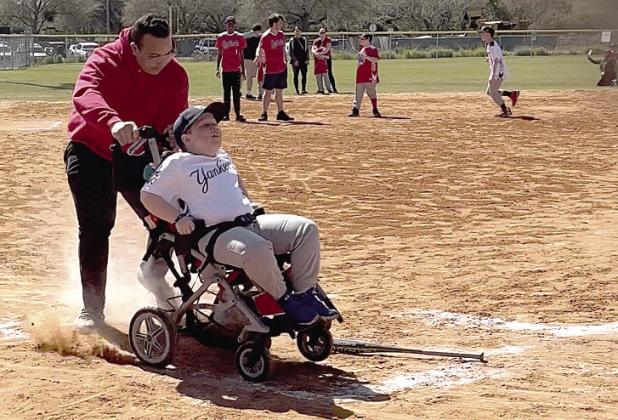A wide grin spread across 10-year-old Noah Riley’s face as he crossed home plate Saturday during the Opening Day game of the St. Cloud Little League Challenger Division.
“It’s just fun!” he said after the game. “I also play sled hockey, but baseball is my favorite.”
As part of nearly 900 players spread across some 90 teams, Noah and 43 other athletes have registered for the spring baseball season with Challenger, Little League’s adaptive baseball program for individuals with physical and intellectual challenges. The St. Cloud Division was started in 2010 by John Giambrone and is now run by Christy Depuy. There is no cost to players in the division, and no age limit.
“When we started, it did have a cap of 18 (years old). Now we are ageless. I’ve coached adults that are older than me,” Depuy said. “Four to 99 is basically our age limit.
“We don’t charge our players to play. But our uniforms themselves are over $2,000 per year, plus new equipment, gloves, and things like that.”
For the past two years, Depuy applied for and received the Community Betterment Grant, which provides that $2,000 toward uniforms and supplies. It’s funds from that grant and Challenger sponsors that make the division possible.
Noah’s father, Steve Riley, is the coach of his team, the Yankees. “I absolutely love it,” he said. “I look forward to it every week.”
Riley’s teenage son Steven is the coach of the opposing team, the Cardinals. He was in the eighth grade when he first came out to help.
“At first, he was like, ‘Do I have to?’” his father said. But within a few weeks, he said Steven was the one insisting it was time to head to the fields. “And it’s been that way ever since.”
Now Steven is not just helping but is coaching a team. And the players love him. Riley said, “There’s one child here who is supposed to be in the other division because he’s aged up, but he said, ‘No move up.’ When we asked him why, he pointed at Steven.” “His favorite person in life is his coach,” Depuy said. “His mom told me that unless coach is moving up with him, he’s not going to go.”
And based on the grin on Steven’s face, the feeling is mutual.
In addition to players and coaches, “buddies” are scattered around the ball field. Buddies are youth and adult volunteers who are matched with players to help them in whatever way they need— helping them bat, pushing their wheelchair around the bases, and always encouraging them.
“These kids play for the legitimate love of the game,” Depuy said. “There’s no stress. There’s no competition. And (helping with Challenger) teaches kids a lot about inclusion, and making sure that child sitting by themselves doesn’t sit by themselves,” Depuy said. “No matter what the case is, whether they’re special needs or they’re just having a rough day.”
If you would like to volunteer to be a buddy with the Challenger program, contact Christy Depuy at christy9980@gmail.com.




